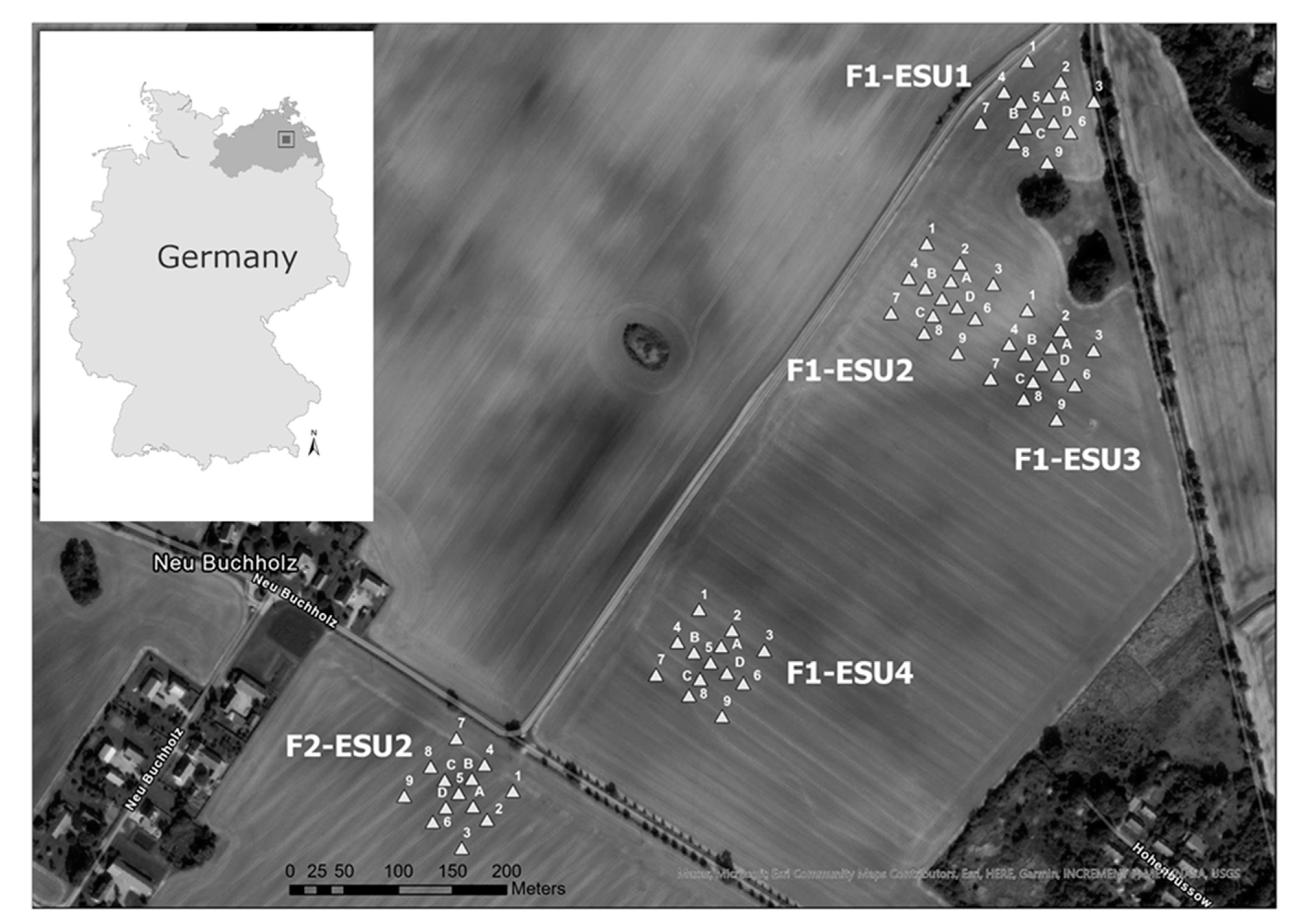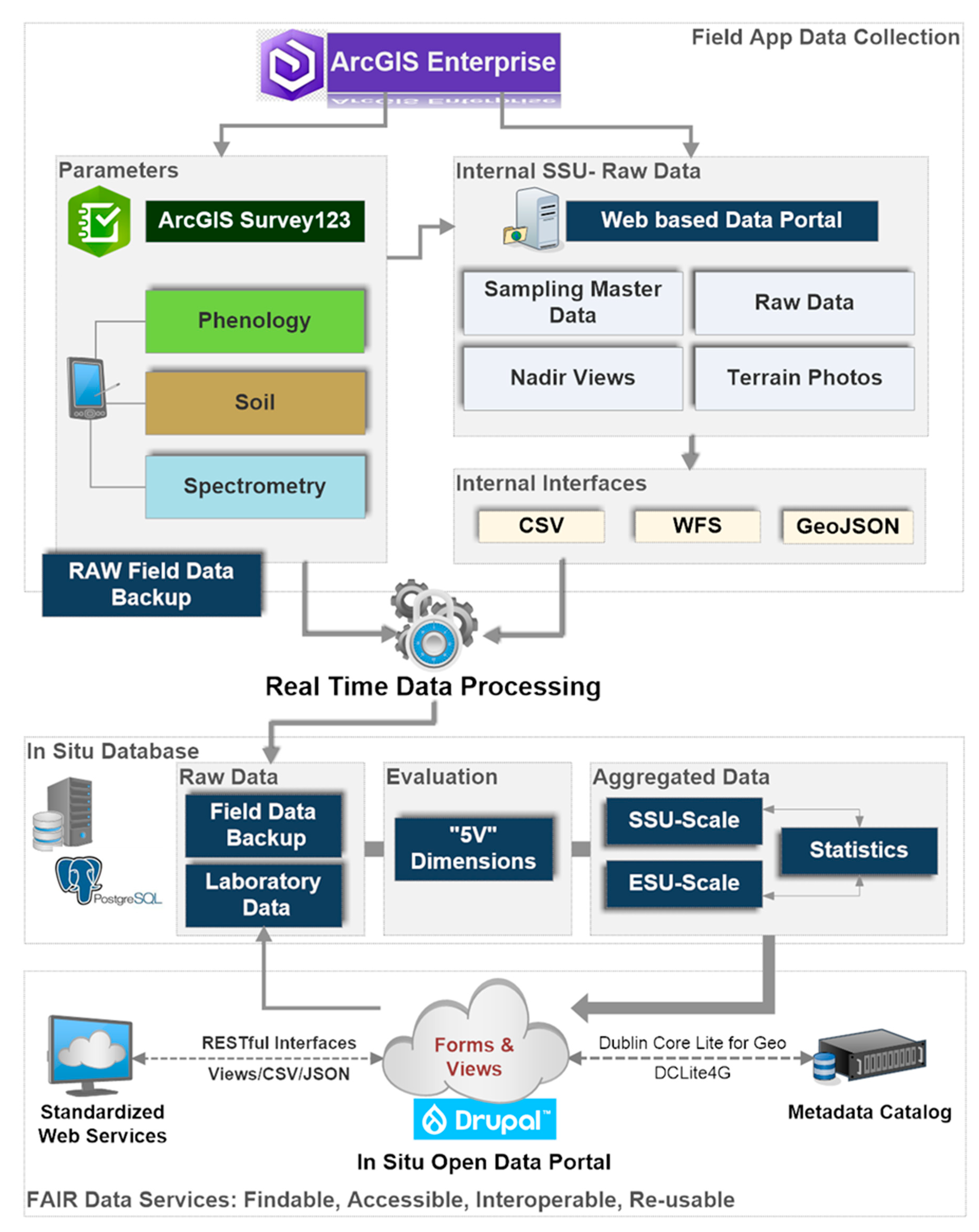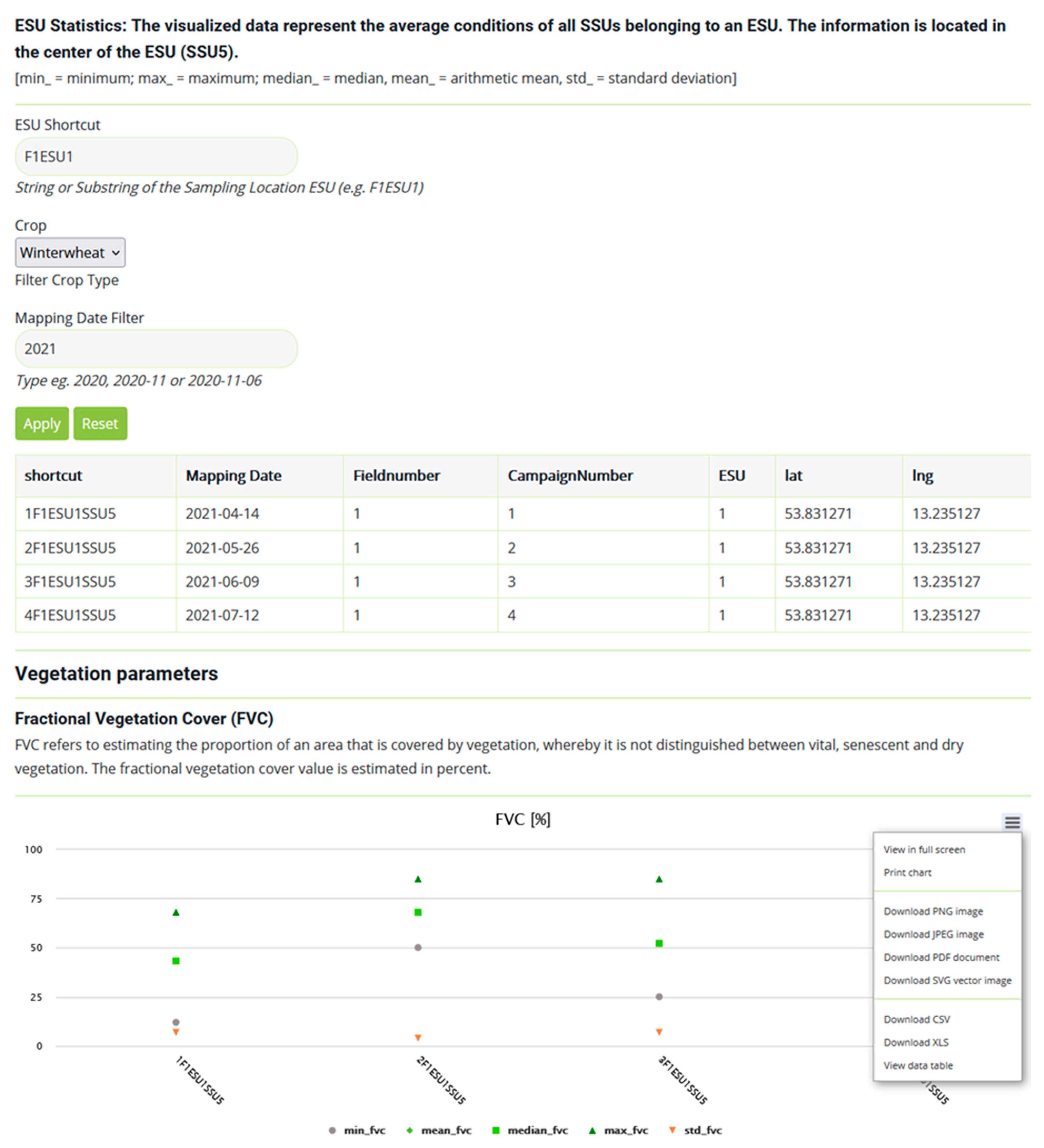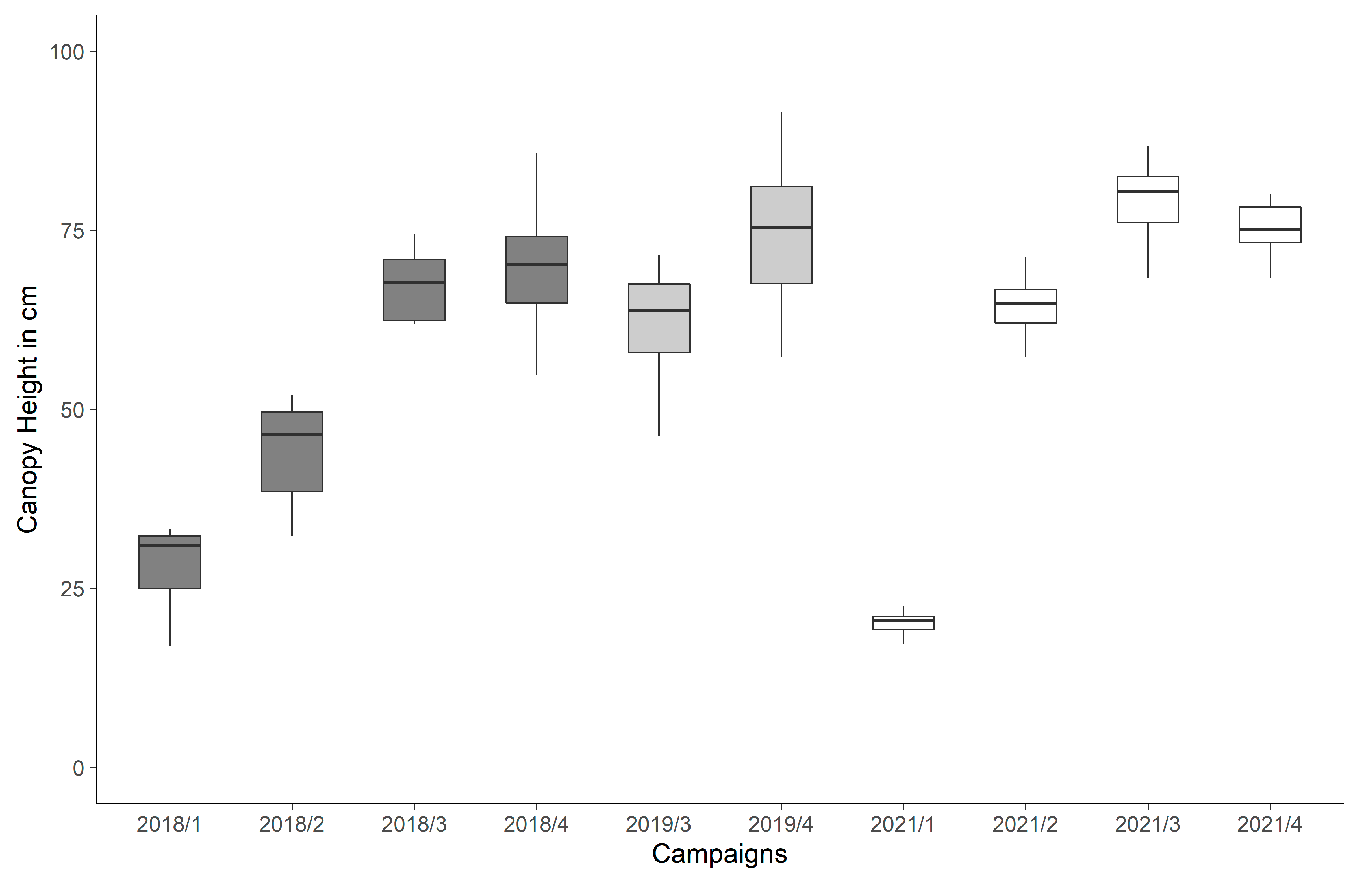Digital In Situ Data Collection in Earth Observation, Monitoring and Agriculture—Progress towards Digital Agriculture
Abstract
:1. Introduction
2. Materials and Methods
2.1. Study Site: DEMMIN
2.2. Prerequisites and challenges
3. Results
4. Discussion
5. Conclusions
Supplementary Materials
Author Contributions
Funding
Data Availability Statement
Acknowledgments
Conflicts of Interest
References
- FAO. World Programme for the Census of Agriculture 2020. Volume 2 Operational Guidelines; FAO statistical development series; FAO: Rome, Italy, 2018; Volume 16, ISBN 978-92-5-131032-8. [Google Scholar]
- Kamilaris, A.; Kartakoullis, A.; Prenafeta-Boldú, F.X. A Review on the Practice of Big Data Analysis in Agriculture. Comput. Electron. Agric. 2017, 143, 23–37. [Google Scholar] [CrossRef]
- Lytos, A.; Lagkas, T.; Sarigiannidis, P.; Zervakis, M.; Livanos, G. Towards Smart Farming: Systems, Frameworks and Exploitation of Multiple Sources. Comput. Netw. 2020, 172, 107147. [Google Scholar] [CrossRef]
- Mercier, A.; Betbeder, J.; Baudry, J.; Le Roux, V.; Spicher, F.; Lacoux, J.; Roger, D.; Hubert-Moy, L. Evaluation of Sentinel-1 & 2 Time Series for Predicting Wheat and Rapeseed Phenological Stages. ISPRS J. Photogramm. Remote Sens. 2020, 163, 231–256. [Google Scholar] [CrossRef]
- Mulla, D.J. Twenty Five Years of Remote Sensing in Precision Agriculture: Key Advances and Remaining Knowledge Gaps. Biosyst. Eng. 2013, 114, 358–371. [Google Scholar] [CrossRef]
- Weiss, M.; Jacob, F.; Duveiller, G. Remote Sensing for Agricultural Applications: A Meta-Review. Remote Sens. Environ. 2020, 236, 111402. [Google Scholar] [CrossRef]
- Abd El-Kader, S.M.; Mohammad El-Basioni, B.M. Precision Agriculture Technologies for Food Security and Sustainability; Advances in Environmental Engineering and Green Technologies; IGI Global: Hershey, PA, USA, 2021; Available online: https://www.igi-global.com/gateway/book/244644 (accessed on 8 January 2022)ISBN 978-1-79985-000-7.
- Fajardo, M.; Whelan, B.M. Within-farm Wheat Yield Forecasting Incorporating Off-farm Information. Precis. Agric. 2021, 22, 569–585. [Google Scholar] [CrossRef]
- Wolfe, M.L.; Richard, T.L. 21st Century Engineering for On-Farm Food–Energy–Water Systems. Curr. Opin. Chem. Eng. 2017, 18, 69–76. [Google Scholar] [CrossRef]
- Khanal, S.; Kc, K.; Fulton, J.P.; Shearer, S.; Ozkan, E. Remote Sensing in Agriculture—Accomplishments, Limitations, and Opportunities. Remote Sens. 2020, 12, 3783. [Google Scholar] [CrossRef]
- Sishodia, R.P.; Ray, R.L.; Singh, S.K. Applications of Remote Sensing in Precision Agriculture: A Review. Remote Sens. 2020, 12, 3136. [Google Scholar] [CrossRef]
- Whitcraft, A.K.; Becker-Reshef, I.; Justice, C.O.; Gifford, L.; Kavvada, A.; Jarvis, I. No Pixel Left behind: Toward Integrating Earth Observations for Agriculture into the United Nations Sustainable Development Goals Framework. Remote Sens. Environ. 2019, 235, 111470. [Google Scholar] [CrossRef]
- Defourny, P.; Bontemps, S.; Bellemans, N.; Cara, C.; Dedieu, G.; Guzzonato, E.; Hagolle, O.; Inglada, J.; Nicola, L.; Rabaute, T.; et al. Near Real-Time Agriculture Monitoring at National Scale at Parcel Resolution: Performance Assessment of the Sen2-Agri Automated System in Various Cropping Systems around the World. Remote Sens. Environ. 2019, 221, 551–568. [Google Scholar] [CrossRef]
- Weersink, A.; Fraser, E.; Pannell, D.; Duncan, E.; Rotz, S. Opportunities and Challenges for Big Data in Agricultural and Environmental Analysis. Annu. Rev. Resour. Econ. 2018, 10, 19–37. [Google Scholar] [CrossRef]
- Wolfert, S.; Ge, L.; Verdouw, C.; Bogaardt, M.-J. Big Data in Smart Farming—A Review. Agric. Syst. 2017, 153, 69–80. [Google Scholar] [CrossRef]
- Bontemps, S.; Bajec, K.; Cara, C.; Defourny, P.; de Vendictis, L.; Heymans, D.; Kucera, L.; Malcorps, P.; Milcinski, G.; Nicola, L.; et al. Sen4CAP—Sentinels for Common Agricultural Policy: System Software User Manual 2020; ESA: Louvain-la-Neuve, Belgium, 2021. [Google Scholar]
- Koetz, B.; Defourny, P.; Bontemps, S.; Bajec, K.; Cara, C.; de Vendictis, L.; Kucera, L.; Malcorps, P.; Milcinski, G.; Nicola, L.; et al. SEN4CA—Sentinels for CAP Monitoring Approach. In Proceedings of the 2019 JRC IACS Workshop, Valladolid, Spain, 10–11 April 2019. [Google Scholar]
- ESA. Sen4cap—Project Background. Available online: http://esa-sen4cap.org/content/project-background (accessed on 28 December 2021).
- Long, T.B.; Blok, V.; Coninx, I. Barriers to the Adoption and Diffusion of Technological Innovations for Climate-Smart Agriculture in Europe: Evidence from the Netherlands, France, Switzerland and Italy. J. Clean. Prod. 2016, 112, 9–21. [Google Scholar] [CrossRef]
- Chi, M.; Plaza, A.; Benediktsson, J.A.; Sun, Z.; Shen, J.; Zhu, Y. Big Data for Remote Sensing: Challenges and Opportunities. Proc. IEEE 2016, 104, 2207–2219. [Google Scholar] [CrossRef]
- Manakos, I.; Lavender, S. Remote Sensing in Support of the Geo-Information in Europe. In Land Use and Land Cover Mapping in Europe; Manakos, I., Braun, M., Eds.; Remote Sensing and Digital Image Processing; Springer: Dordrecht, The Netherlands, 2014; Volume 18, pp. 3–10. ISBN 978-94-007-7968-6. [Google Scholar]
- Nativi, S.; Bigagli, L. Discovery, Mediation, and Access Services for Earth Observation Data. IEEE J. Sel. Top. Appl. Earth Obs. Remote Sens. 2009, 2, 233–240. [Google Scholar] [CrossRef]
- Giuliani, G.; Egger, E.; Italiano, J.; Poussin, C.; Richard, J.-P.; Chatenoux, B. Essential Variables for Environmental Monitoring: What Are the Possible Contributions of Earth Observation Data Cubes? Data 2020, 5, 100. [Google Scholar] [CrossRef]
- Nativi, S.; Mazzetti, P.; Santoro, M.; Papeschi, F.; Craglia, M.; Ochiai, O. Big Data Challenges in Building the Global Earth Observation System of Systems. Environ. Model. Softw. 2015, 68, 1–26. [Google Scholar] [CrossRef]
- Craglia, M.; Nativi, S. Mind the Gap: Big Data vs. Interoperability and Reproducibility of Science. In Earth Observation Open Science and Innovation; Mathieu, P.-P., Aubrecht, C., Eds.; Springer International Publishing: Cham, Switzerland, 2018; pp. 122–141. ISBN 978-3-319-65632-8. [Google Scholar]
- Giuliani, G.; Masó, J.; Mazzetti, P.; Nativi, S.; Zabala, A. Paving the Way to Increased Interoperability of Earth Observations Data Cubes. Data 2019, 4, 113. [Google Scholar] [CrossRef] [Green Version]
- Lehmann, A.; Masò, J.; Nativi, S.; Giuliani, G. Towards Integrated Essential Variables for Sustainability. Int. J. Digit. Earth 2020, 13, 158–165. [Google Scholar] [CrossRef]
- Pettorelli, N.; Safi, K.; Turner, W. Satellite Remote Sensing, Biodiversity Research and Conservation of the Future. Philos. Trans. R. Soc. B 2014, 369, 20130190. [Google Scholar] [CrossRef] [PubMed]
- Bastin, L.; Buchanan, G.; Beresford, A.; Pekel, J.-F.; Dubois, G. Open-Source Mapping and Services for Web-Based Land-Cover Validation. Ecol. Inform. 2013, 14, 9–16. [Google Scholar] [CrossRef] [Green Version]
- JRC. Gridded Agro-Meteorological Data in Europe. 2021. Available online: https://agri4cast.jrc.ec.europa.eu/DataPortal/SignIn.aspx?idResource=7&o=d (accessed on 18 August 2021).
- WMO. Data Collection or Production Centre (DCPC) for the World Weather Information Service (WWIS). 2021. Available online: https://dcpc.worldweather.org/dcpc/ (accessed on 18 August 2021).
- Institute for Environment and Sustainability. LUCAS Topsoil Survey: Methodology, Data and Results; EU Commission JRC: Luxembourg, 2013. [Google Scholar]
- Cushing, J.B.; Kaplan, N.E.; Laney, C.; Mallett, J.; Ramsey, K.; Vanderbilt, K.L.; Zeman, L.; Gao, J.; Kruger, J.; LeRoy, C.; et al. Integrating Ecological Data: Notes from the Grasslands ANPP Data Integration Project. In Proceedings of the Ecoinformatics Conference Service, Environmental Information Management 2008, Albuquerque, NM, USA, 10–11 September 2008. [Google Scholar]
- Eagle, A.J.; Christianson, L.E.; Cook, R.L.; Harmel, R.D.; Miguez, F.E.; Qian, S.S.; Ruiz Diaz, D.A. Meta-Analysis Constrained by Data: Recommendations to Improve Relevance of Nutrient Management Research. Agron. J. 2017, 109, 2441–2449. [Google Scholar] [CrossRef] [Green Version]
- Elliott, K.C.; Cheruvelil, K.S.; Montgomery, G.M.; Soranno, P.A. Conceptions of Good Science in Our Data-Rich World. Bioscience 2016, 66, 880–889. [Google Scholar] [CrossRef]
- Jolivot, A.; Lebourgeois, V.; Ameline, M.; Andriamanga, V.; Bellón, B.; Castets, M.; Crespin-Boucaud, A.; Defourny, P.; Diaz, S.; Dieye, M.; et al. Harmonized in Situ JECAM Datasets for Agricultural Land Use Mapping and Monitoring in Tropical Countries. Earth Syst. Sci. Data 2021, 13, 5951–5967. [Google Scholar] [CrossRef]
- Delgado, J.A.; Vandenberg, B.; Kaplan, N.; Neer, D.; Wilson, G.; D’Adamo, R.; Carter, J.; O’Gan, L.; Grow, N.; Marquez, R.; et al. Agricultural Collaborative Research Outcomes System (AgCROS): A Network of Networks Connecting Food Security, the Environment, and Human Health. J. Soil Water Conserv. 2018, 73, 158A–164A. [Google Scholar] [CrossRef] [Green Version]
- ESA. Copernicus: Factsheet Agriculture Socio-Economic Benefits. 2018. Available online: https://www.copernicus.eu/sites/default/files/2018-11/10%20FACTSHEETS_Socio-economic_V3%203.pdf# (accessed on 21 July 2021).
- Herold, M.; Woodcock, C.E.; di Gregorio, A.; Mayaux, P.; Belward, A.S.; Latham, J.; Schmullius, C.C. A Joint Initiative for Harmonization and Validation of Land Cover Datasets. IEEE Trans. Geosci. Remote Sens. 2006, 44, 1719–1727. [Google Scholar] [CrossRef]
- Kobayashi, K.; Nasahara, K.; Tadono, T.; Ohgushi, F.; Dotsu, M.; Dan, R. Development and Update of “SACLAJ” a Multi-Temporal Ground Truth Dataset of Land Cover. In Proceedings of the International Symposium on Remote Sensing, Nagoya University, Nagoya, Japan, 17–19 May 2017. [Google Scholar]
- Nagai, S.; Nasahara, K.N.; Akitsu, T.K.; Saitoh, T.M.; Muraoka, H. Importance of the Collection of Abundant Ground-Truth Data for Accurate Detection of Spatial and Temporal Variability of Vegetation by Satellite Remote Sensing. In Geophysical Monograph Series; Dontsova, K., Balogh-Brunstad, Z., Le Roux, G., Eds.; Wiley: Hoboken, NJ, USA, 2020; pp. 223–244. ISBN 978-1-119-41330-1. [Google Scholar]
- Nasahara, K.N.; Nagai, S. Review: Development of an in Situ Observation Network for Terrestrial Ecological Remote Sensing: The Phenological Eyes Network (PEN). Ecol. Res. 2015, 30, 211–223. [Google Scholar] [CrossRef]
- Wilkinson, M.D.; Dumontier, M.; Aalbersberg, I.J.J.; Appleton, G.; Axton, M.; Baak, A.; Blomberg, N.; Boiten, J.-W.; Da Silva Santos, L.B.; Bourne, P.E.; et al. The FAIR Guiding Principles for Scientific Data Management and Stewardship. Sci. Data 2016, 3, 160018. [Google Scholar] [CrossRef] [PubMed] [Green Version]
- Coetzee, S.; Ivánová, I.; Mitasova, H.; Brovelli, M.A. Open Geospatial Software and Data: A Review of the Current State and A Perspective into the Future. ISPRS Int. J. Geo-Inf. 2020, 9, 90. [Google Scholar] [CrossRef] [Green Version]
- Pommier, C.; Michotey, C.; Cornut, G.; Roumet, P.; Duchêne, E.; Flores, R.; Lebreton, A.; Alaux, M.; Durand, S.; Kimmel, E.; et al. Applying FAIR Principles to Plant Phenotypic Data Management in GnpIS. Plant. Phenomics 2019, 2019, 1671403. [Google Scholar] [CrossRef] [PubMed] [Green Version]
- Rotz, S.; Duncan, E.; Small, M.; Botschner, J.; Dara, R.; Mosby, I.; Reed, M.; Fraser, E.D.G. The Politics of Digital Agricultural Technologies: A Preliminary Review. Sociol. Rural. 2019, 59, 203–229. [Google Scholar] [CrossRef]
- Capalbo, S.M.; Antle, J.M.; Seavert, C. Next Generation Data Systems and Knowledge Products to Support Agricultural Producers and Science-Based Policy Decision Making. Agric. Syst. 2017, 155, 191–199. [Google Scholar] [CrossRef] [PubMed]
- Klerkx, L.; Jakku, E.; Labarthe, P. A Review of Social Science on Digital Agriculture, Smart Farming and Agriculture 4.0: New Contributions and a Future Research Agenda. NJAS-Wagening. J. Life Sci. 2019, 90, 100315. [Google Scholar] [CrossRef]
- Tereno. Tereno Test Site DEMMIN. 2021. Available online: https://www.tereno.net/joomla/index.php/observatories/northeast-german-lowland-observatory/test-sites (accessed on 17 November 2021).
- Spengler, D.; Ahmadian, N.; Borg, E.; Harfenmeister, K.; Hohmann, C.; Hüttich, C.; Itzerott, S.; Maass, H.; Missling, K.-D.; Schmullius, C.; et al. The German JECAM Site DEMMIN: Status and Future Perspectives. In Proceedings of the Annual JECAM Meeting, Taichung, Taiwan, 17–20 September 2018. [Google Scholar]
- Borg, E.; Conrad, C.; Truckenbrodt, S.; Hüttich, C.; Ahmadian, N.; Thorsten, D.; Heupel, K.; Spengler, D.; Missling, K.-D. Joint Experiment for Crop Assessment and Monitoring (JECAM) Test Site DEMMIN 2018. In Proceedings of the International Geoscience and Remote Sensing Symposium, IGARSS 2018, the 38th Annual Symposium, Valencia, Spain, 24 August 2018. [Google Scholar]
- Morisette, J.T.; Baret, F.; Privette, J.L.; Myneni, R.B.; Nickeson, J.E.; Garrigues, S.; Shabanov, N.V.; Weiss, M.; Fernandes, R.A.; Leblanc, S.G.; et al. Validation of Global Moderate-Resolution LAI Products: A Framework Proposed within the CEOS Land Product Validation Subgroup. IEEE Trans. Geosci. Remote Sens. 2006, 44, 1804–1817. [Google Scholar] [CrossRef] [Green Version]
- Baret, F.; Weiss, M.; Allard, D.; Garrigues, S.; Leroy, M. VALERI: A Network of Sites and a Methodology for the Validation of Medium Spatial Resolution Land Satellite Products 2021. ffhal-03221068f. Available online: https://hal.inrae.fr/hal-03221068 (accessed on 8 January 2022).
- Ding, Y.; Ge, Y.; Hu, M.; Wang, J.; Wang, J.; Zheng, X.; Zhao, K. Comparison of Spatial Sampling Strategies for Ground Sampling and Validation of MODIS LAI Products. Int. J. Remote Sens. 2014, 35, 7230–7244. [Google Scholar] [CrossRef]
- ESRI ArcGIS Survey123 Smarter Forms, Smarter Data Collection. Available online: https://www.esri.com/en-us/arcgis/products/arcgis-survey123/overview (accessed on 21 July 2021).
- ESRI Esri Education Institution License Program Overview—International. Available online: https://www.esri.com/content/dam/esrisites/en-us/media/pdf/Esri-Edu-Institution-License-Program-Overview-Intl-7-2019.pdf (accessed on 21 July 2021).
- ESRI ArcGIS REST API—Working with Services You’ve Published. Available online: https://developers.arcgis.com/rest/services-reference/working-with-services-you-ve-published.htm (accessed on 21 July 2021).
- DRUPAL DRUPAL. Available online: https://www.drupal.org/ (accessed on 21 July 2021).
- ESRI How Can I Share My Data with a Member of Another Organization? Available online: https://doc.arcgis.com/de/arcgis-online/reference/faq.htm#anchor90 (accessed on 21 July 2021).
- Herzmann, D.E.; Abendroth, L.J.; Bunderson, L.D. Data Management Approach to Multidisciplinary Agricultural Research and Syntheses. J. Soil Water Conserv. 2014, 69, 180A–185A. [Google Scholar] [CrossRef] [Green Version]
- Dhillon, M.S.; Dahms, T.; Kuebert-Flock, C.; Borg, E.; Conrad, C.; Ullmann, T. Modelling Crop Biomass from Synthetic Remote Sensing Time Series: Example for the DEMMIN Test Site, Germany. Remote Sens. 2020, 12, 1819. [Google Scholar] [CrossRef]
- Hosseini, M.; McNairn, H.; Mitchell, S.; Robertson, L.D.; Davidson, A.; Ahmadian, N.; Bhattacharya, A.; Borg, E.; Conrad, C.; Dabrowska-Zielinska, K.; et al. A Comparison between Support Vector Machine and Water Cloud Model for Estimating Crop Leaf Area Index. Remote Sens. 2021, 13, 1348. [Google Scholar] [CrossRef]
- Scholes, R.J.; Mace, G.M.; Turner, W.; Geller, G.N.; Jürgens, N.; Larigauderie, A.; Muchoney, D.; Walther, B.A.; Mooney, H.A. Toward a Global Biodiversity Observing System. Science 2008, 321, 1044–1045. [Google Scholar] [CrossRef]
- Fang, H.; Baret, F.; Plummer, S.; Schaepman-Strub, G. An Overview of Global Leaf Area Index (LAI): Methods, Products, Validation, and Applications. Rev. Geophys. 2019, 57, 739–799. [Google Scholar] [CrossRef]
- Chianucci, F. An Overview of in Situ Digital Canopy Photography in Forestry. Can. J. For. Res. 2019, 227–242. [Google Scholar] [CrossRef]
- Bateman, H.L.; Lindquist, T.E.; Whitehouse, R.; Gonzalez, M.M. Mobile Application for Wildlife Capture-Mark-Recapture Data Collection and Query: Mobile Application for Field Studies. Wildl. Soc. Bull. 2013, 37, 838–845. [Google Scholar] [CrossRef]
- McCaffrey, K.J.W.; Jones, R.R.; Holdsworth, R.E.; Wilson, R.W.; Clegg, P.; Imber, J.; Holliman, N.; Trinks, I. Unlocking the Spatial Dimension: Digital Technologies and the Future of Geoscience Fieldwork. J. Geol. Soc. 2005, 162, 927–938. [Google Scholar] [CrossRef] [Green Version]
- Andrachuk, M.; Marschke, M.; Hings, C.; Armitage, D. Smartphone Technologies Supporting Community-Based Environmental Monitoring and Implementation: A Systematic Scoping Review. Biol. Conserv. 2019, 237, 430–442. [Google Scholar] [CrossRef]
- Wich, S.A.; Piel, A.K. Conservation Technology; Oxford University Press: New York, NY, USA, 2021; ISBN 978-0-19-885024-3. [Google Scholar]
- Teacher, A.G.F.; Griffiths, D.J.; Hodgson, D.J.; Inger, R. Smartphones in Ecology and Evolution: A Guide for the App-Rehensive. Ecol. Evol. 2013, 3, 5268–5278. [Google Scholar] [CrossRef]




Publisher’s Note: MDPI stays neutral with regard to jurisdictional claims in published maps and institutional affiliations. |
© 2022 by the authors. Licensee MDPI, Basel, Switzerland. This article is an open access article distributed under the terms and conditions of the Creative Commons Attribution (CC BY) license (https://creativecommons.org/licenses/by/4.0/).
Share and Cite
Teucher, M.; Thürkow, D.; Alb, P.; Conrad, C. Digital In Situ Data Collection in Earth Observation, Monitoring and Agriculture—Progress towards Digital Agriculture. Remote Sens. 2022, 14, 393. https://doi.org/10.3390/rs14020393
Teucher M, Thürkow D, Alb P, Conrad C. Digital In Situ Data Collection in Earth Observation, Monitoring and Agriculture—Progress towards Digital Agriculture. Remote Sensing. 2022; 14(2):393. https://doi.org/10.3390/rs14020393
Chicago/Turabian StyleTeucher, Mike, Detlef Thürkow, Philipp Alb, and Christopher Conrad. 2022. "Digital In Situ Data Collection in Earth Observation, Monitoring and Agriculture—Progress towards Digital Agriculture" Remote Sensing 14, no. 2: 393. https://doi.org/10.3390/rs14020393
APA StyleTeucher, M., Thürkow, D., Alb, P., & Conrad, C. (2022). Digital In Situ Data Collection in Earth Observation, Monitoring and Agriculture—Progress towards Digital Agriculture. Remote Sensing, 14(2), 393. https://doi.org/10.3390/rs14020393





